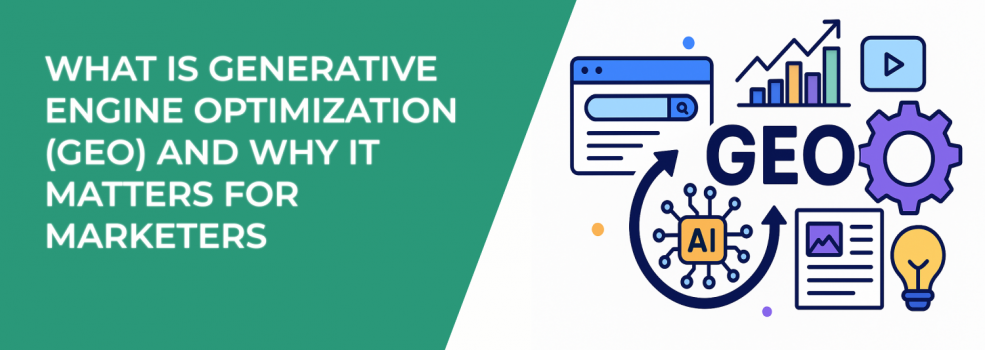Search is changing quickly. Many users no longer scroll through endless links. Instead, they turn to AI-powered tools like ChatGPT or Google’s AI Overviews for direct answers. These tools generate complete responses, often leaving traditional search results unseen.
For marketers, advertisers, and business owners, that creates a new challenge. A customer might ask, “What’s the best strategy for Facebook ads?” The AI delivers a ready-made answer. If the response highlights a competitor’s content and ignores yours, your brand is excluded from the conversation.
Generative Engine Optimization (GEO) is designed to solve this. GEO is the practice of shaping content so that AI engines recognize it, trust it, and use it in their answers. In a world where users may never click a link, visibility depends on being part of the response itself.
Why GEO Matters for Marketers
Three main reasons explain why GEO should be on every marketer’s radar:
-
AI engines now control visibility. Ranking high on Google matters less if people see only AI-generated answers. GEO helps ensure that your content shows up in those answers.
-
Mentions build credibility. A brand name inside an AI response can shape trust even if the user doesn’t click through. That visibility strengthens recognition over time.
-
Early adoption creates an advantage. Most businesses still focus only on SEO. Marketers who begin with GEO now can secure visibility before competitors understand the shift.
This shift is part of a much broader transformation. As AI reshapes Facebook ads and other platforms, the rules for digital visibility continue to evolve. Marketers who adapt early will stay visible while others fall behind.
Core Principles of GEO
To succeed with GEO, marketers should focus on a few key principles that make content useful both for readers and for AI engines.
-
Clear structure. AI tools process information more easily when content is broken into small sections. Use headings, short paragraphs, and summaries. For example, a tutorial on ad targeting should be presented as labeled steps rather than one long explanation.
-
Direct answers to real questions. Keywords alone are not enough. Content should anticipate and fully answer the questions users are asking. A page about “Facebook ad budgets” should explain budget levels for small businesses, mid-sized firms, and larger advertisers.
-
Authority through evidence. AI engines favor content backed by solid information. Pages enriched with relevant statistics have 37% more chances of being cited in AI answers. Adding current data makes a page more reliable and more attractive to engines.
-
Expert credibility. Generative systems also prefer content that demonstrates expertise. Including direct quotes from recognized experts raises the chance of being cited by around 45%. Expert voices make both readers and machines see the content as trustworthy.
-
Machine readability. Schema markup and clean metadata help AI engines identify the type and structure of content. A page with FAQ schema, for example, is more likely to be used in generated answers.
-
External validation. Mentions in industry media, backlinks, and references from other credible sites act as proof of authority. AI engines weigh these signals heavily when deciding which sources to include.
These principles align closely with the bigger shifts happening in digital marketing. Search engines and social platforms increasingly rely on algorithms that prioritize clarity, credibility, and intent. Understanding how algorithms shape what customers see makes it clear why GEO is becoming so important.
Examples of GEO in Action
To see how GEO works in practice, consider these scenarios:
-
A digital agency writes a guide on “How to Create a Facebook Ad Funnel.” The article includes an FAQ section at the end. When users ask AI tools about funnels, those FAQ answers are often pulled directly into the response.
-
An online retailer publishes a holiday marketing calendar and adds structured data to the dates. When someone searches “best days to advertise before Christmas,” the AI engine includes the retailer’s calendar in its answer.
-
A SaaS company posts updated statistics about ad performance benchmarks. When a user asks about average click-through rates, the SaaS company’s data appears in the generated response.
In each case, the brand wins visibility by being embedded in the answer. That exposure shapes perception before the customer even clicks a website link.
How to Start With GEO
Marketers can begin implementing GEO with a focused approach. Starting small makes the process practical and manageable.
-
Choose one high-value page. Select a guide, blog post, or FAQ that aligns with business goals. This page becomes the test case.
-
Make the content easy to scan. Use headings, short sections, and bullet points. Organized pages are easier for both readers and AI engines to handle.
-
Add credible data. Include recent statistics, case examples, or research findings. Evidence strengthens authority and increases the chances of being cited.
-
Include expert insights. Adding quotes or commentary from trusted professionals builds credibility. Expert voices show both readers and AI systems that the content is reliable.
-
Apply schema markup. Structured data for FAQs, how-to steps, or product details helps AI tools recognize the purpose of each section.
-
Promote externally. Share the content through partnerships, PR outreach, or social channels. Mentions and backlinks reinforce authority signals.
These steps work alongside broader trends in online marketing. As the future of Facebook ads becomes increasingly shaped by AI-driven automation, GEO gives marketers a way to control how their content appears inside those answers.
Pitfalls to Avoid
When implementing GEO, some mistakes reduce the effectiveness of the work. Here are the most common ones and why they matter:
-
Keyword stuffing without useful answers. Pages that repeat phrases without providing depth lose credibility. AI engines look for value, not repetition. A page that says “Facebook ad budget” over and over but never explains spending levels won’t be used.
-
Relying on outdated or weak data. Old statistics or vague claims signal low authority. AI systems prefer content that includes fresh, well-sourced information. Updating data regularly keeps content relevant.
-
Unstructured, dense content. Long blocks of text without headings or summaries are difficult to process. Engines need clear markers to identify key insights. Breaking information into sections improves readability and visibility.
-
Using one format everywhere. Different AI systems evaluate content in different ways. What works for Google’s AI Overviews may not suit ChatGPT or Perplexity. Testing across platforms helps uncover the best approaches.
The lesson here is simple: the same issues that hold ads back also hurt GEO. Just as AI trends in advertising push marketers to adapt, GEO requires careful alignment between clarity, data, and credibility.
Final Thoughts
Generative Engine Optimization is no longer optional. SEO continues to help pages rank, but GEO determines whether a brand is included inside the answers that people actually see.
When customers ask AI tools about advertising, marketing, or your industry, the engine will choose certain voices to highlight. Brands that prepare now with GEO will be present in those answers, shaping decisions at the moment they happen.
This is part of the bigger story of how AI transforms digital marketing. The platforms marketers rely on are shifting, and strategies must shift too. As AI continues to reshape advertising and algorithms dictate visibility, GEO becomes a core skill for staying competitive.
The question is simple: when someone asks AI about your market, will the answer include your brand or your competitor’s?

